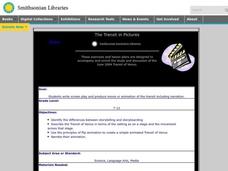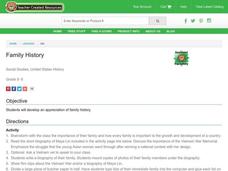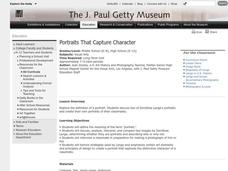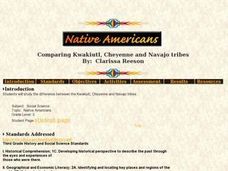Curated OER
The Transit in Pictures
Students investigate the June 2004 Transit of Venus, write a screen play, and produce a movie or animation of the transit including a narration. The difference between storytelling and storyboarding is made clear in this lesson.
Facing History and Ourselves
The Range of Choices
Learners examine crimes against human rights. In this world history instructional activity, students watch a segment of a video about the Armenian Genocide. Learners reflect on the crimes of the Ottoman government in classroom...
Scholastic
Reading Symbols
Philip Pullman's The Golden Compass serves as the anchor text for a lesson on symbolism. Readers use the provided worksheets to examine the symbols in the novel as well as in the world around them.
Curated OER
Family History
Students appreciate how families are important to the expansion and progress of a country. In this biographies lesson, students read a biography and write their biographies including photos. Students create family trees.
Curated OER
Darfur Now Lesson Two: Responding to the Violence in Darfur
Students explore the concept of political activism. In this Darfur conflict lesson, students watch "Darfur Now" and consider the stories of the political activists featured. Students use the information regarding the activists to create...
Curated OER
Portraits That Capture Character
Students analyze two of Dorothea Lange's portraits and create their own portraits of classmates. In this portrait analysis lesson, students define portrait and discuss two images of Lange's. Students interview a classmate and use Lange's...
Curated OER
What Difference Does A Name Make?
Students view the film The Persuaders that discuss the perspective and spin of language use for a variety of issues. They discuss the career of Frank Luntz, a man that runs focus groups to determine how to advantageously phrase issues in...
Curated OER
Children's March Teacher's Guide, Activity 1
Young scholars study how political movements involve students as well as adults. They discover that young scholars of all ages have the power to make a difference in the world.
Curated OER
Comparing Kwakiutl, Cheyenne and Navajo tribes
Third graders study the difference between the Kwakiutl, Cheyenne and Navajo tribes. They identify the people, resources, lifestyle and beliefs of the Kwakiutl, Cheyenne, and Navajo Indians. Afterward, they present their projects on each...
Curated OER
Final Performance of a Play
Second graders study theatre by designing a play, studying actors, and work in partners to create a story to perform. In this theatre study instructional activity, 2nd graders discuss theatre as live theatre, television, film, and radio....
Curated OER
Primary and Secondary Sources
Students understand what primary and secondary sources are. In this primary and secondary sources instructional activity, students take a list of sources and break down to primary and secondary sources.
Curated OER
Activism
Students use a leading question in order to create context for the activity. The use of media helps to engage students with the integration of technology. Students consider major problems of society.
Curated OER
What If Things Were Different
Students understand how history is made, in terms of the individuals responsible for actions in the past and in terms of those in the present who preserve and interpret stories from the past.The subject matter relates to gender and...
Curated OER
The Persuaders
Have your upper graders watch the documentary, "The Persuaders" as they explore how advertisers try to gain potential customers. The video is followed by a discussion and close examination of new marketing trends and strategies.















